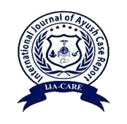A Ray of Light on Pittashmari (Gall Bladder Stones) as per Ayurvedic Principle- Case Series
Abstract
Gallstones form when bile stored in the gallbladder hardens into stone-like material. Too much cholesterol, bile salts, or bilirubin (bile pigment) can cause gallstones. In this era of where lifestyle of people is improper who consume more junk and street foods there are developing cases seen under this disease condition. As per contemporary science the main treatment modality for this condition is surgery due to distress from the surgical procedure people are turning towards science of medicine for non-surgical procedures. The context Ashmari in Ayurveda represents stone which is described under the context of Bastighata Ashmari. After revising Ayurvedic texts we come across the bile secreted from gallbladder can be correlated with Accha Pitta mentioned in ayurveda due to similarity in location and function.in ayurvedic context Pittaashmari is not directly explained.in this theory of Pittaashmari is explains as the Ashmari (stone) which usually combines with urine here it gets combined with pitta with help of Vata and get lodges in Pittaashaya to form Pittaashmari. The present article an attempt is made to manage and portray the non-surgical management through Ayurvedic point of view.

This work is licensed under a Creative Commons Attribution-NonCommercial-NoDerivatives 4.0 International License.

